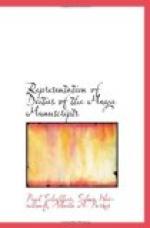Finally the owl and the ape (or monkey) must be mentioned as animals of mythologic significance, of which we have already spoken in connection with gods A and C. The scorpion also seems to have an important mythologic significance, and appears in the manuscripts in connection with figures of gods, as, for example, in Cort. 7a and Tro. 31*a, 33*a, 34*a (god M with a scorpion’s tail). In addition to those discussed in this paper, there are a few animals in the manuscripts, which probably also have a partial mythologic significance, but which have been omitted because they are represented in a naturalistic manner, thus, for example, the deer on Tro. 8, et seq., while idealization (with human bodies, with torches, hieroglyphic character on the head, etc.) should be considered as an unmistakable sign of mythologic meaning.
A mythologic significance also seems to belong to the bee which plays so prominent a part of the Codex Troano. Probably the section in question of the Madrid manuscript (1* et seq.) treats of bee-keeping, but incidentally it certainly has to do also with the mythologic conceptions connected with the culture of bees.
The bat which is found as a mythological figure on pottery vessels and inscriptions from the Maya region (compare Seler, Zeitschrift fuer Ethnologie, 1894, p. 577) does not occur in the manuscripts. It is true, however, that hieroglyphic signs, which seem to relate to the head of the bat, occur in isolated cases in the manuscripts.
SUMMARY.
An enumeration of the most important deities in the manuscripts gives the following results, in connection with which it is to be noted that, of course, the numbers cannot be absolutely correct, because one or another of the pictures occasionally remains doubtful. As far as possible, however, only the positively determined representations have been considered.
The deity occurring most frequently in the DRESDEN MANUSCRIPT is god B, who is pictured there 141 times. Following him in point of number in the same manuscript are the death-god A pictured 33 times, god D 19 times, and gods C and E 17 and 14 times respectively.
In the MADRID MANUSCRIPT, god D, with 84 pictures, is of most frequent occurrence. He is followed by the maize-god E with 76 pictures, god B with 71, god A with 53, C with 38 and M with 37 pictures.
In the PARIS MANUSCRIPT, god E’s picture can be verified 8 times, those of C and B 6 times each and that of god A twice; N and K are also frequently represented.
An enumeration of all the pictures in all the manuscripts shows that the following deities occur most frequently and are therefore to be considered the most important:




